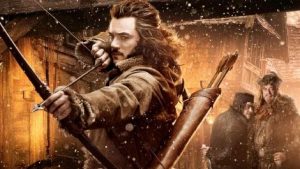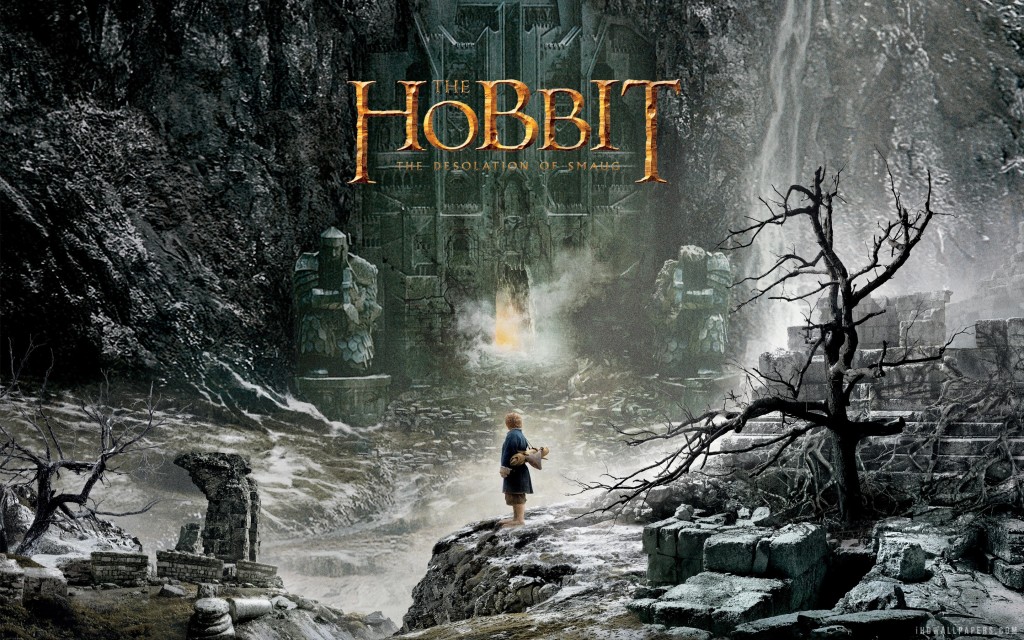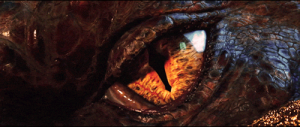Peter Jackson was always going to have problems with his reputation after The Lord of the Rings, it’s a tough act to follow, but he carried on making the films that he wanted to make and maligned as they were (King Kong: overlong, The Lovely Bones: boneless) they were still his films, not an attempt to make lightning strike twice. The first Hobbit film fell under similar scrutiny even before it came out due to decisions made about the length and quantity of films that would ultimately end up in theatres, to say nothing of the ill-fated 48fps experiment, but despite all that it was still the film Jackson wanted to make. So is this one.
The Desolation of Smaug is the first Middle-Earth adaptation made by Peter Jackson not to implement a volume or chapter title from one of the original novels, which I find to be very fitting since this film noticeably deviates from the original source material and is very much its own beast. My typical response to people who moaned about the idea of stretching a short children’s novel into a long running trilogy is that Jackson was never directly adapting The Hobbit, he was using the story as a jumping off point and going on to further realize the world of Middle-Earth through the majestic landscape of New Zealand and the talent of its artisans. Unfortunately while the first film succeeded in doing this, the actual plot ended up being spread quite thin with not enough time devoted to character development and too many action sequences, it isn’t often a film well over 2 hours feels hurried, but An Unexpected Journey does.
The other issue I had with the first one initially was the way it looked, The Lord of the Rings had a tangible, almost realist aesthetic that owed to a surprisingly limited budget and reliance on very old-school, craftsmanship-led production design, it felt like a window you could have stepped through. The Hobbit films had a far bigger budget and the decade that CGI’s had to advance is taken full advantage of. An Unexpected Journey looks glossy, dreamlike and at times very artificial. Comparisons to LOTR are unfair and uncalled for but I was so inspired by that trilogy that some part of me was always going to yearn for even a spark from the same fire that Jackson lit under me with Fellowship. Much as I liked the first Hobbit I never got it, but with this one I did.
It follows on very directly from the where the first film left off, with Bilbo and the dwarves trying to elude an orc pack and progress further towards the Lonely Mountain. From there the film takes them through encounters with a skin-changer, a cluster of spiders the size of light aircraft, the mercurial wood elves, the rather depressing Laketown and finally the dragon lurking in the depths of the abandoned dwarven mega-city of Erebor. While this is going on parallel plot strands involving Gandalf, Radagast, the Necromancer and a digitally (and rather uncannily) aged-down Legolas are woven in.
The Desolation of Smaug irons out a lot of the issues that the first one had, it still branches out and delves deeper into the dark machinations that would eventually lead to the events of LOTR but it also wisely dedicates a lot of time to character, giving us a far clearer picture of the dwarf company as well as a closer look at some of the more incidental characters from the book, like Bard (played skilfully by Luke Evans, making no effort to tone down his Welshness). As such, the plot fills out the time well and never drags or rushes, all the dialogue sequences and set pieces are distinct and memorable, not to mention gripping.

The aesthetic still carries over from the first film but I take less of an issue with it now, it’s still glossy and cartoonish but that makes a certain amount of sense, it doesn’t mean it isn’t the same world, we’re just looking at it through a different lens. As a matter of fact the only real issues I have with this film stem from the fact that I know the novel really well, a few times I found myself trying to pre-empt narrative beats.
I actually kind of envy anybody who goes into this film cold because it’s going to grab hold of them from minute one. There is an ever-present sense of looming peril and mounting intrigue as more layers are painted on and more creatures and locations are brought to life. The dark, treacherous forest of Mirkwood is particularly memorable, partly for the hallucinogenic effect it has on the dwarves and partly for the decidedly unfriendly things that inhabit it. Martin Freeman knocks it out of the park again, providing us with a braver, more measured Bilbo who is already contending with the consuming properties of the ring. Ian McKellen is a foregone conclusion and the dwarves are almost uniformly improved, with Aidan Turner’s Kili and Ken Stott’s Balin enjoying increased spotlight focus. Lee Pace makes an appropriately slimy Thranduil and Evangeline Lilly has a career high performance as the new-for-the-film elf Tauriel, creating a clever plot strand that serves to better tie the events of this film with events forthcoming. The star of the film however is the titular Smaug, enlivened with a glazing, almost seductive drawl eminent of Shere Khan or Scar provided by Benedict Cumberbatch.
It would have been so easy to cast Smaug as a malevolent, un-knowable evil akin to Sauron but Jackson took the smarter route and gave us the Smaug I’d always imagined, a pompous, fat, arrogant narcissist. He spends much of his wonderful verbal confrontation with Bilbo bragging about how he knew the dwarves would come and how nobody could ever outsmart him. We’ve had plenty of cinematic experience with dragons that breath fire, but this is the first one we’ve seen blow so much hot air.
This film represents The Hobbit film series emerging from uncertainty and becoming something solid and easy to grasp, something sure of itself. Gone are the experiments with frame-rate and the unhappy marriage of overbearing CGI and what appeared to be aerial shots from a New Zealand tourist agency advert. This is a potent, confident addition to the cannon of Tolkien-by-way-of-Jackson that will captivate fans of the source material and grab the layman by the balls. I can’t wait to see how the final installment turns out.
Some of the coverage you find on Cultured Vultures contains affiliate links, which provide us with small commissions based on purchases made from visiting our site.





